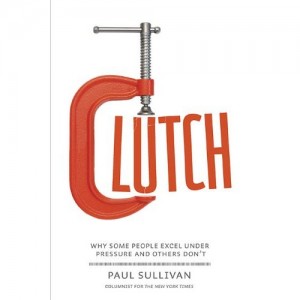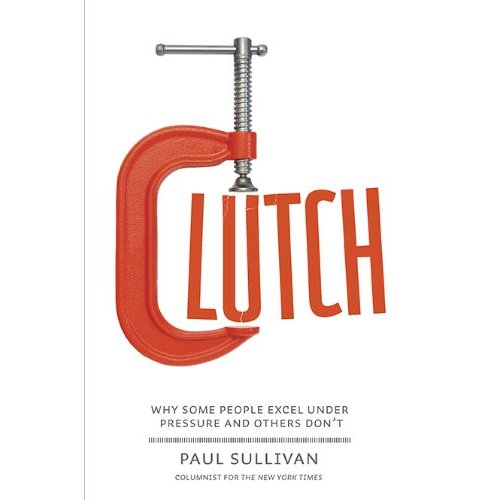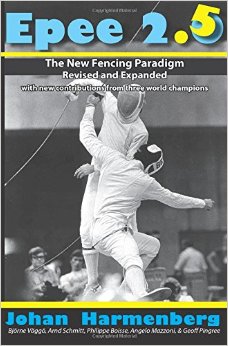 What does it take to go from being down 11-4 to win a bout 15-14? Why do some people seem to find ways to win while others can’t seem to catch a lucky break when it’s 4-4 or 14-14? Is this type of performance just luck, innate ability, or is it a learn-able skill?
What does it take to go from being down 11-4 to win a bout 15-14? Why do some people seem to find ways to win while others can’t seem to catch a lucky break when it’s 4-4 or 14-14? Is this type of performance just luck, innate ability, or is it a learn-able skill?
I’ve started back on my reading binge and just finished “Clutch: Why Some People Excel Under Pressure and Other Don’t” by Paul Sullivan. In the book Sullivan starts off with a few scenarios including a “Hail Mary” pass or the pinch hitter that hits the game winning home run off the first pitch and argues that those are more luck than clutch. In his definition, a clutch performance is more sustained than one play or one repetition.
He defines five main characteristics of being “clutch” and shows examples from the sports and business worlds of the characteristics in action.
Why people are Clutch. People who are strong “in the clutch” players exhibit focus, discipline, ability to adapt, being present, and being driven by, not paralyzed by, fear and desire.
Applying these to fencing, I was thinking these would be applicable to:
Focus – Knowing what your goals and game plan are and discarding the extraneous stuff.
Discipline – The ability to keep focus on your long term goals to execute and learn every skill at practice. The ability to keep within your gameplan during a tournament or bout.
Adapting – Find quickly if something is not working and adjust your game accordingly rather than trying to force the action.
Being Present – “Being present” relates some to being “in the zone”. It’s about being in the moment and not worrying about the future (wow, I might get X rating if I win) or hampered by the past (this person has beaten me before.)
Fear and Desire – In the anecdotes, fear of being destitute or the desire to get the mission accomplished were drivers for business and military leaders. In all of the examples the fears and desires served to motivate rather than paralyze the clutch players. If you’re afraid to lose, then you’ll miss out on some opportunities and play it safe and pass up some good opportunities. The clutch players have the ability to recognize those opportunities.
The author also goes into an analysis of why people choke. This part of the book is the counterpoint to why people are clutch, but they are things that I see at every tournament.
The primary cause of choking is a failure to take responsibility. Talk to a “clutch” player who has lost a bout and they will recognize what the other fencer did to beat them. The fencer who chokes will have a checklist of excuses or complaints (they were wearing a chest plate, they got lucky, the referee couldn’t see my actions) which shift responsibility for the defeat off of them and onto the inability of others to do their jobs or the vagaries of the universe.
Another cause for choking is overthinking your actions. This is sort of the opposite side of the spectrum of “being present” and is something that comes up in the book Winning Ugly. When you overthink, you’re thinking through the process of how you do the actions instead of just doing your actions and letting your mind focus on the tactical decisions of the bout.
Sullivan’s final component to choking is overconfidence. The belief that no matter what they don’t have to worry about the outcome and there is no way that they can lose has caused the downfall of many. In fencing we’ll call that “scrubbing out” to someone – and it’s something that many highly rated fencers have had happen.
How do you become clutch? That’s the question, isn’t it? If you’re not already a clutch player, how do you become clutch? Sullivan posits that you can learn to become clutch by developing the five qualities he’s found in the clutch players (athletes, military personnel, and business leaders) that he studied and interviewed. It all starts with taking personal responsibility and a dedicated vision of where you want to be and working on those components.
I found this book to be a quick read. The stories presented highlight each of the qualities and main points the author is pushing forward and they are done in a way where you can break it up in a few minutes of reading at a time. Will this book help your fencing? Who knows. It may help crystallize some ideas in your mind, so grab it from your library for a quick read on your next trip.
Note: The links in this article go out to Amazon.com where you can purchase this book. If you happen to purchase through that link, Fencing.Net gets a small commission.




3 Comments
Comments are closed.